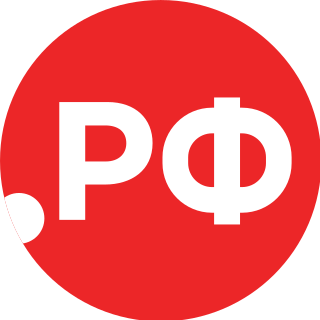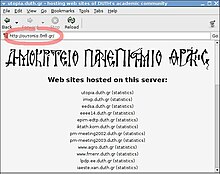The Domain Name System (DNS) is a hierarchical and distributed naming system for computers, services, and other resources in the Internet or other Internet Protocol (IP) networks. It associates various information with domain names assigned to each of the associated entities. Most prominently, it translates readily memorized domain names to the numerical IP addresses needed for locating and identifying computer services and devices with the underlying network protocols. The Domain Name System has been an essential component of the functionality of the Internet since 1985.
A top-level domain (TLD) is one of the domains at the highest level in the hierarchical Domain Name System of the Internet after the root domain. The top-level domain names are installed in the root zone of the name space. For all domains in lower levels, it is the last part of the domain name, that is, the last non empty label of a fully qualified domain name. For example, in the domain name www.example.com, the top-level domain is .com. Responsibility for management of most top-level domains is delegated to specific organizations by the ICANN, an Internet multi-stakeholder community, which operates the Internet Assigned Numbers Authority (IANA), and is in charge of maintaining the DNS root zone.

In the Internet, a domain name is a string that identifies a realm of administrative autonomy, authority or control. Domain names are often used to identify services provided through the Internet, such as websites, email services and more. As of December 2023, 359.8 million domain names had been registered. Domain names are used in various networking contexts and for application-specific naming and addressing purposes. In general, a domain name identifies a network domain or an Internet Protocol (IP) resource, such as a personal computer used to access the Internet, or a server computer.
Punycode is a representation of Unicode with the limited ASCII character subset used for Internet hostnames. Using Punycode, host names containing Unicode characters are transcoded to a subset of ASCII consisting of letters, digits, and hyphens, which is called the letter–digit–hyphen (LDH) subset. For example, München is encoded as Mnchen-3ya.
In computer networking, a hostname is a label that is assigned to a device connected to a computer network and that is used to identify the device in various forms of electronic communication, such as the World Wide Web. Hostnames may be simple names consisting of a single word or phrase, or they may be structured. Each hostname usually has at least one numeric network address associated with it for routing packets for performance and other reasons.
A country code top-level domain (ccTLD) is an Internet top-level domain generally used or reserved for a country, sovereign state, or dependent territory identified with a country code. All ASCII ccTLD identifiers are two letters long, and all two-letter top-level domains are ccTLDs.
The Japan Registry Services Co., Ltd. (JPRS) was incorporated on December 26, 2000. The organization manages the .jp ccTLD, including the operation of the registry and DNS servers.
The Internationalized Resource Identifier (IRI) is an internet protocol standard which builds on the Uniform Resource Identifier (URI) protocol by greatly expanding the set of permitted characters. It was defined by the Internet Engineering Task Force (IETF) in 2005 in RFC 3987. While URIs are limited to a subset of the US-ASCII character set, IRIs may additionally contain most characters from the Universal Character Set, including Chinese, Japanese, Korean, and Cyrillic characters.
The internationalized domain name (IDN) homograph attack is a way a malicious party may deceive computer users about what remote system they are communicating with, by exploiting the fact that many different characters look alike
Single-letter second-level domains are domains in which the second-level domain of the domain name consists of only one letter, such as x.com. In 1993, the Internet Assigned Numbers Authority (IANA) explicitly reserved all single-letter and single-digit second-level domains under the top-level domains com, net, and org, and grandfathered those that had already been assigned. In December 2005, ICANN considered auctioning these domain names.
Many email clients now offer some support for Unicode. Some clients will automatically choose between a legacy encoding and Unicode depending on the mail's content, either automatically or when the user requests it.
ThaiURL is a technology enabling the use of Thai domain names in applications that have been modified to support this technology. It is one of several such systems that were marketed before the advent of IDNA.
International email arises from the combined provision of internationalized domain names (IDN) and email address internationalization (EAI). The result is email that contains international characters, encoded as UTF-8, in the email header and in supporting mail transfer protocols. The most significant aspect of this is the allowance of email addresses in most of the world's writing systems, at both interface and transport levels.

The domain name .рф is the Cyrillic country code top-level domain for the Russian Federation, in the Domain Name System of the Internet. In the Domain Name System it has the ASCII DNS name xn--p1ai. The domain accepts only Cyrillic subdomain applications, and is the first Cyrillic implementation of the Internationalizing Domain Names in Applications (IDNA) system. The domain became operational on 13 May 2010. As of 2014 it is the most used internationalized country code top-level domain, with around 900,000 domain names.
The Arabic name امارات, romanized as emarat, is the internationalized country code top-level domain for the United Arab Emirates. The ASCII name of this domain in the Domain Name System of the Internet is xn--mgbaam7a8h, using the Internationalizing Domain Names in Applications (IDNA) procedure in the translation of the Unicode representation of the script version. The domain was installed in the Domain Name System on 5 May 2010.
مصر is the internationalized country code top-level domain in the Domain Name System (DNS) of the Internet for Egypt. Its ASCII DNS name is xn--wgbh1c, obtained by the Internationalizing Domain Names in Applications (IDNA) transcription method.
An internationalized country code top-level domain is a top-level domain in the Domain Name System (DNS) of the Internet. IDN ccTLDs are specially encoded domain names that are displayed in an end user application, such as a web browser, in their language-native script or alphabet, such as the Arabic alphabet, or a non-alphabetic writing system, such as Chinese characters. IDN ccTLDs are an application of the internationalized domain name system to top-level Internet domains assigned to countries, or independent geographic regions.
An emoji domain is a domain name with one or more emoji in it, for example 😉.tld.
Universal Acceptance (UA) is a term coined by Ram Mohan to represent the principle that every top-level domain (TLD) should function within all applications regardless of script, number of characters, or how new it is.


